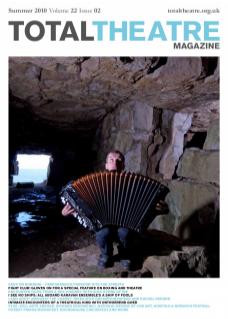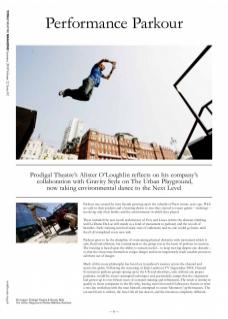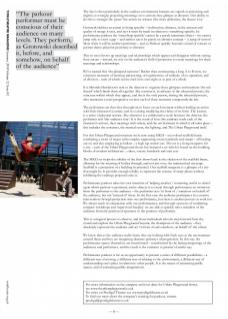Parkour was created by nine friends growing up in the suburbs of Paris twenty years ago. With no cash in their pockets and a burning desire to move they started to create games – trainings – involving only their bodies and the environments in which they played.
These included the now iconic architecture of Evry and Lisses (where the abstract climbing wall La Dame Du Lac still stands as a kind of monument to parkour) and the woods of Sarcelles. Early training involved many tests of endurance and no one would go home until they’d all completed every new task.
Parkour grew to be the discipline of overcoming physical obstacles with movement which is safe, fluid and efficient, but commitment to the group was at the heart of parkour in creation. The training is based upon the ability to remain useful – to keep moving despite any obstacle – so that the traceur may themselves escape danger and more importantly reach another person to aid them out of danger.
Much of this route philosophy has been lost in parkour’s journey across the channel and across the globe. Following the screening of Jump London on TV (September 2004, Channel 4) numerous parkour groups sprang up in the UK and elsewhere, and, without any proper guidance, would-be traceurs attempted techniques and, particularly, jumps that the originators had grown up to over fifteen years of constant training and refinement. The result is similar in quality to those companies in the 60s who, having seen Grotowski’s laboratory theatre or after a two day workshop with the man himself, attempted to create ‘laboratory’ performances. The outward form is similar, the inner life all but absent, and the intention completely different.
Whilst attending the Odin Teatret with Dah Teatar back in 1998 I read an article by theatre scholar Franco Ruffini entitled Mime, the Actor, Action: The Way of Boxing. The author discusses the effect of various kinds of physical training on theatre movements in France during the first half of the twentieth century, tracking changes in theatre performance against developments in boxing and particularly the career of The Orchid Man, Georges Carpentier.
Carpentier demonstrates the new athleticism appearing around the turn of the last century and exemplified in the Natural Method of Physical Training, created by Naval training instructor Georges Hébert, who reacted against the ‘action specific’ fitness of weight lifting and called for a new training to take place in the open air and which was inspired by tribal trainings he’d observed in the French colonies, and the movement of the ‘topmen’ or ‘button men’ – the sailors who worked in the masts and rigging of the tall ships on which he travelled. In common with the tribal hunters, they carried none of the weightlifter’s bulk, but possessed a holistic, adaptable and versatile strength based in the ability to employ the entire body in the making of any action.
This ‘natural’ method of training was adopted by the French Navy and gave the world the ‘parcours du combattant’ or ‘assault course’. Most interesting for us is the knowledge that this method was also adopted by Jacques Copeau and helped to inspire the work of his student Etienne Decroux (the godfather of contemporary corporeal mime).
Where we differed from others who watched Jump London was that we immediately made the connection between modern ‘parkour’ and the ‘parcours’ of Georges Hébert. We brought our knowledge of movement from dance and theatre into our parkour and from the outset tried to work with the same principles we use in our release-based training.
Copeau loved ‘methode naturelle’ as it is based in truth – you cannot act your way over a wall – either you get over it or you don’t. If performance is to be based on the presentation of truth it is essential that a performer’s training is premised on truthful actions.
Parkour is a contemporary flowering of the utilitarian principle, explored by Copeau, Decroux, and later Grotowski. It is extraordinarily utilitarian, in fact, requiring only the imagination and commitment of the traceur and an environment – any environment – in which to move.
The ideal traceur would hone their economy of action to such a degree that the casual observer would barely notice their passage through a space. The traceur would notice the audience only in terms of their impact on a shared environment. This does not make for a good performance…
How then to move parkour into performance?
We hold as a basic premise that the performer’s job is to provide the opportunity and context in which the witness becomes creative. To this end the performer must be conscious of their audience on many levels. They perform, as Grotowski described it, ‘before, and somehow, on behalf of the audience’.
In performance, the traceur becomes a dancer, and must obey all the same principles that any dancer works with. Conveniently, this means that parkour can be seen in performance as a language of dance and by that distinction it can be a partner to other forms of dance/theatre.
The partnership between Prodigal Theatre and Gravity Style (the organisation of Charles Perriere and Malik Diouf – two of the nine co-creators of Parkour) is a partnership between performance-makers of different disciplines. Our work is based on the evolution of a distinctive performance language for parkour.
It is this that distinguishes our work from the adoption of parkour techniques that has been seen on several occasions in the performance world, and equally distinguishes our work from the demonstrations of technique which have passed for performance in the parkour world.
In working with parkour in the creation of performances we’ve also gained an education in the process of creating work for outdoor spaces.
It is apparent that our general process of making sense of others in our environment is based on a rapid perception of intention, through projection of meaning onto action. Unwieldy sentence – but understandable if we take the following example: Whilst walking down the street you see someone sitting on the kerb and another person run to and crouch beside them. The reasons behind this set of actions could be any of an infinite number: someone is hurt and a stranger seeks to comfort them; someone is late and their friend has sat to wait for them – and in the process of witnessing actions we project reasons or meaning onto them. Our projections are based on our ability to read intentions – and this comes down to our perception of the qualities of energy employed in the actions and so on.
The fact is that particularly in the outdoor environment humans are superb at perceiving and (rightly or wrongly) projecting meanings on to actions they glimpse at distance. Our ability to do this is stronger the ‘purer’ the action we witness (the more utilitarian, the clearer it is).
Grotowski defines an action as being specific – in direction, distance, in the amount and quality of energy it uses, and says it must be made in relation to something specific. In performance parkour the ‘something specific’ cannot be a purely inanimate object – we cannot jump only to cross a gap – and neither can it be purely an abstract concept – ‘a jump of sorrow’. Most often it will be another performer – and so Parkour quickly becomes a kind of contact or partner dance played at proximity or distance.
This in turn throws up meetings and relationships which appear and disappear without stating their nature – instead, we rely on the audience’s skill of projection to create meanings for these meetings and relationships.
We’ve named this ‘the glimpsed narrative’. Rather than constructing a long A to B story, we construct moments of meeting and parting, of togetherness, of solitude, of co-operation, and of division – each of which can be read in its own right or as part of a whole.
It is Miranda Henderson’s task as the director to organise these glimpses and maintain ‘the red thread’ which binds them all together. She constructs, in advance of the rehearsal process, the structure within which they appear, and she is the only person, during the rehearsal process, who maintains a total perspective on how each of these moments compounds the last.
The performers are then free throughout to focus on each moment without loading an action with their character’s journey, and in so doing muddying the clarity of its form. The journey is a series of physical actions. The character is a collaborative work between the director, the performer and ‘this audience now’. It is the result of how this audience reads each of the character’s actions, their meetings with others, and the environment in which it all takes place – this includes the costumes, the musical score, the lighting, and The Urban Playground itself.
For this Urban Playground structure we’re now using MKII – an evolved scaffold frame combining a series of stages with complex supporting struts, handrails and ramps – all loading out of, and also employing as ballast – a high top transit van. The set is a living maquette for a city – each of the Urban Playground shows has featured a set which is based on the building blocks of modern architecture – cubes, towers, handrails and stair sets.
The MKII set strips the solidity of the first shows back to the skeleton of the scaffold frame, allowing for the weaving of bodies through, and not just over, the miniaturised cityscape. Scaffold is a projection of a building in potential. Our scaffold maquette is a glimpse of a city that might be. It provides enough solidity to represent the essence of many places without inhibiting the readings projected onto it.
Performance parkour takes the root intention of ‘helping another / remaining useful to others’ upon which parkour is premised, and re-directs it to create through performance an invitation from the performer to the audience – the performer acts ‘in front of / somehow on behalf of’ the audience, but not ‘instead of’ them. In the first case the audience participates in a creative intervention through projection onto our performance, but there is another process at work too. We always teach in conjunction with our performances, and through a process of combining compact workshops and ‘supervised freeplay’ we are able to quickly move members of the audience from the position of spectator to the position of performer.
This is a magical process to observe, and those individuals who do step forward from the crowd and explore the Urban Playground become the champions of the audience – they absolutely represent the audience and act ‘in front of and somehow, on behalf of’ the others.
We know that as the audience walks home they are looking with fresh eyes at the environment around them and they are imagining alternate pathways of progression. In this way the performance spaces themselves are transformed – transformed by the lasting imaginings of the audiences and performers, and the result is the existence in potential of another way.
Performance parkour is for us an opportunity to present a series of different possibilities – a different way of moving, a different way of relating to the environment, a different way of understanding one’s place in relation to other people. It is the means of animating public spaces, and of animating public imaginations.
For more information on the company and tour dates for Urban Playground shows, see www.theurbanplayground.co.uk
For more on Prodigal Theatre see www.prodigaltheatre.co.uk
To find out more about the company’s training for parkour, contact prodigal@prodigaltheatre.co.uk



